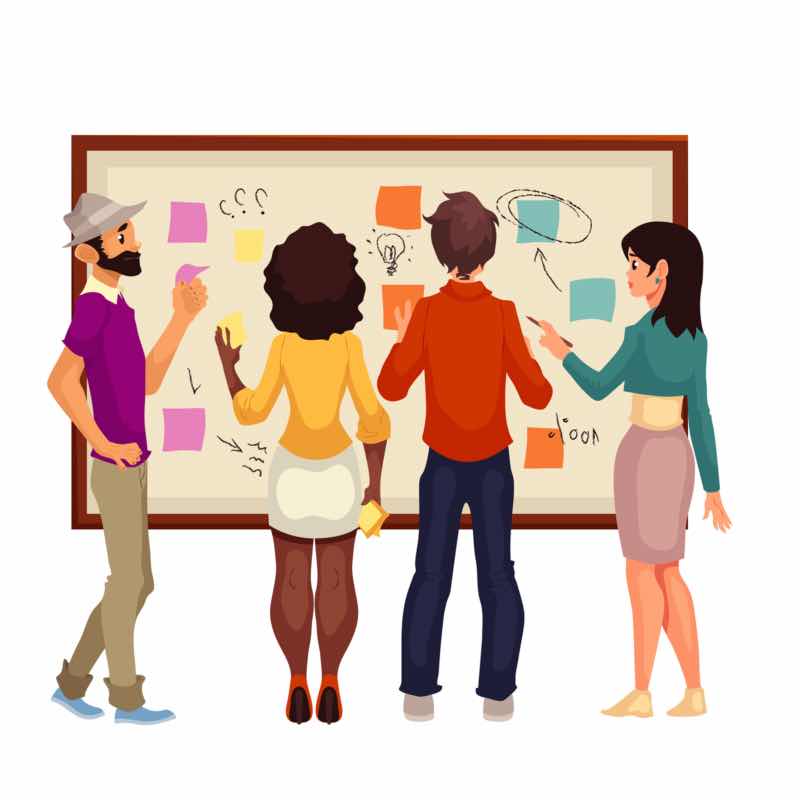When engaging participants in our “respectful workplace training” sessions at Fiore Group, I like to take a page out of Edward de Bono’s Six Thinking Hats philosophy. I find that it’s a very effective way to brainstorm ideas and bring issues to the surface in a very anonymous and objective way. It also forces employees to think critically about the level of respect that’s felt and demonstrated at their workplace.
De Bono uses the idea of Six Thinking Hats (and their associated colours), to represent a different type of thinking. When you “put on” one of the hats, the idea is that you think exclusively in that one specific way when considering a question or issue.
Variation on the Four Hats
In my workshop version, I use a variation on four of those hats:
- Black Hat (Logical & Negative)
- Green Hat (New Ideas & Possibilities)
- Yellow Hat (Logical & Positive)
- Red Hat (Feelings, Intuition, Emotions)
I ask the participants to view their workplace from the various perspectives that de Bono suggests and then to think about these questions:
- What two Respectful Workplace challenges do you face here? (Black Hat)
- What two areas of improvement regarding Respect in the Workplace can we examine? (Green Hat)
- What are two things regarding Respect in the Workplace that we do very well here? (Yellow Hat)
- What two things do you like best about working here? (Red Hat)
The participants are given just one of these questions on a piece of paper attached to a clipboard, and are given badges to wear that identify which question they hold.
Here are the rules, don’t worry they’re easy enough:
- Each participant must walk around the room and find three other people and ask them each the question that they were given.
- Each of the three people they speak to must be holding a question of a different colour than their own.
- They can only speak to one person from each other colour.
Just in case I lost you, here’s an example:
If I hold the Black Hat question, I need to find a person holding the Red Hat question, someone holding the Green Hat question, and then finally a person holding the Yellow Hat question.
In a very dynamic and interactive way, each participant quickly fills up their clipboard with the answers from three different people and has also been interviewed by three people with regards to their own questions.
The next enlightening stage is to put all of the answers to each of the four questions up on the wall (I usually transfer all of the answers to each question on flip chart paper and place them in each corner of the room).
Very soon, the walls are filled with all of the responses given by everyone in the room to each of the four questions.
What happens next? Everyone wanders around the room and places a check mark on the three answers for each question that they feel best represents their workplace experience. It’s also the time when each participant sees every other answer that was provided.
Oftentimes, people will vote for an answer other than the one they gave, perhaps because it was something that they hadn’t thought about before.
Then the tallying begins.
I typically focus on the top three answers given in each of the four categories.
In case you’re curious how this might play out, here is an example of the results from just one of our recent experiences with a client group:
What two Respectful Workplace challenges do you face? (Black Hat)
- Friendly banter that crosses the line
- Holding people accountable
- Governing the limits of humour
What two areas of improvement regarding Respect in the Workplace can we examine? (Green Hat)
- Teaching our staff how to better communicate in times of conflict
- Consistent treatment of all employees
- Rumour mill suppression
What are two things regarding Respect in the Workplace that we do very well here? (Yellow Hat)
- Listening to the needs of our employees
- Team bonding
- Including people in decisions affecting them when we can
What two things do you like best about working here? (Red Hat)
- The people I work with
- Making a positive difference in the workplace
- Freedom to be creative
Now that the results are in, we focus on what they mean to us, particularly honing in on the challenges (Black Hat) and the things that we can do better (Green Hat). This is a great way for the organization to gain insight on how its employees feel, as well as to gather some ideas on how to improve things. In short, the process has delivered a ‘to do’ list of things they should direct their attention to.
Our clients love the inter-creative nature of this exercise and how quickly (and anonymously) relevant information can be mined from the workshop participants.
You may be shocked to hear this, but not one person has the exclusive right, or responsibility, to come up with the best ideas. The person who has been there four days may hold the answer to an issue that the business has been struggling with for four years!
After all, perspective is everything.
But perhaps the most important question is the final one of the day:
What are you going to do with all of this information?
The answer to that could be worth 64,000 dollars!
So now I ask you…Do you know how people feel about their treatment in your organization?







Leave A Comment